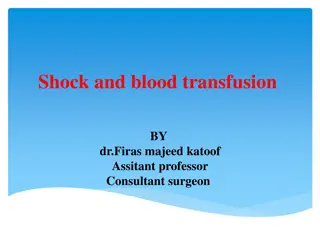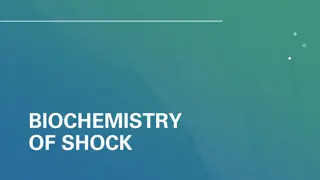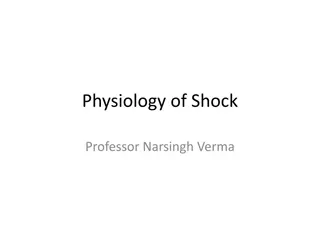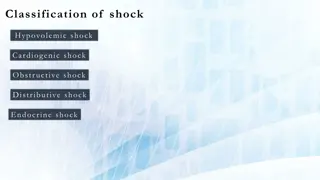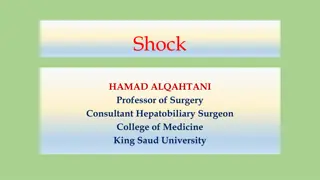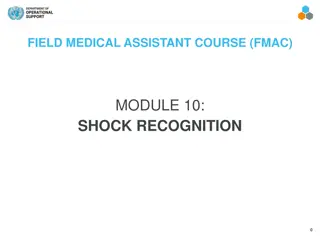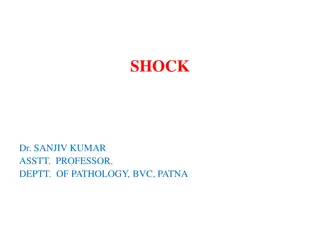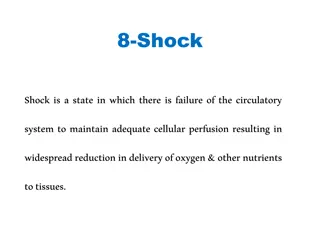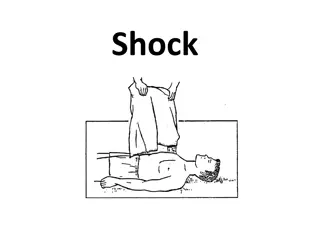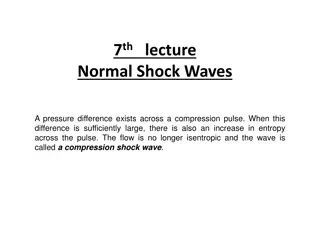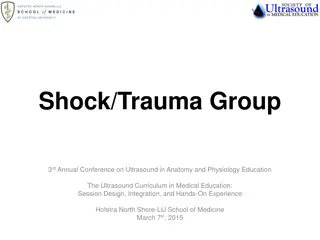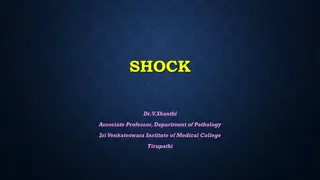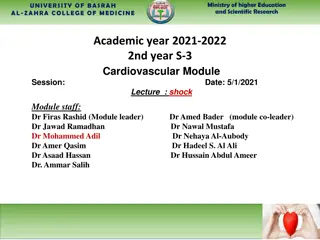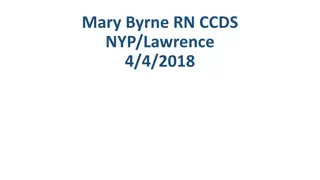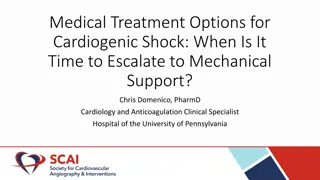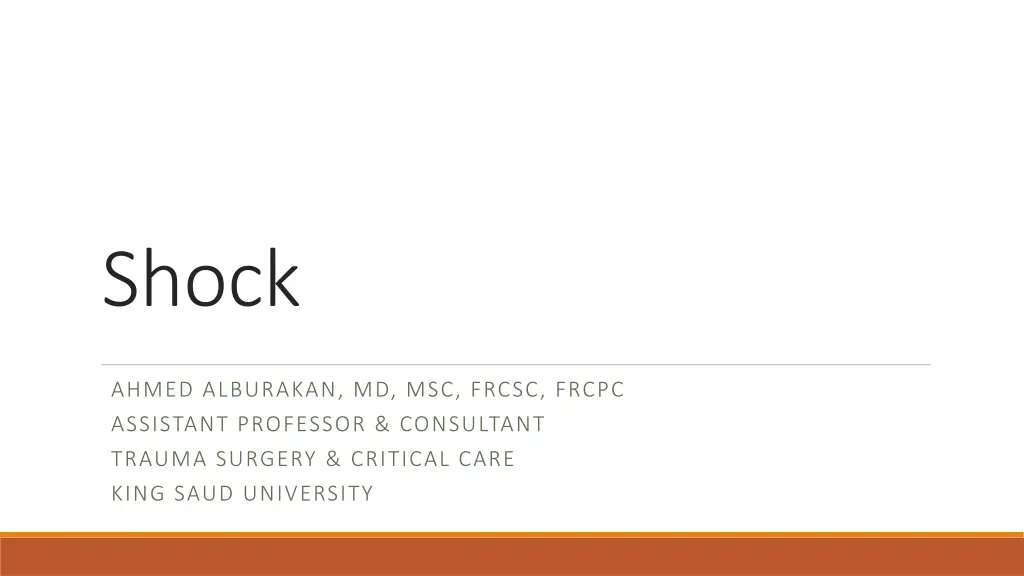
Understanding Shock: Causes, Symptoms, and Treatment Explained by Dr. Ahmed Alburakan
Learn about the concept of shock from Dr. Ahmed Alburakan, covering inadequate oxygen delivery, autonomic responses, cellular effects, multiorgan dysfunction syndrome, and types of shock. Understand the importance of circulatory system function, systemic oxygen delivery, and the progression of shock leading to organ failure.
Download Presentation

Please find below an Image/Link to download the presentation.
The content on the website is provided AS IS for your information and personal use only. It may not be sold, licensed, or shared on other websites without obtaining consent from the author. If you encounter any issues during the download, it is possible that the publisher has removed the file from their server.
You are allowed to download the files provided on this website for personal or commercial use, subject to the condition that they are used lawfully. All files are the property of their respective owners.
The content on the website is provided AS IS for your information and personal use only. It may not be sold, licensed, or shared on other websites without obtaining consent from the author.
E N D
Presentation Transcript
Shock AHMED ALBURAKAN, MD, MSC, FRCSC, FRCPC ASSISTANT PROFESSOR & CONSULTANT TRAUMA SURGERY & CRITICAL CARE KING SAUD UNIVERSITY
Shock What is Shock?
Shock Inadequate oxygen delivery to meet metabolic demand. Results in global tissue hypoperfusion and metabolic acidosis Shock can occur with a normal blood pressure, and hypotension can occur without shock
Shock Oxygen delivery is the function of the circulatory system. This system is basically: - Pump (heart) - Pipes (vessels) - Solution (blood) Needs to function at adequate pressure, volume and carrying capacity.
Understanding Shock Inadequate systemic oxygen delivery activates autonomic responses to maintain systemic oxygen delivery Sympathetic nervous system NE, epinephrine, dopamine, and cortisol release Causes vasoconstriction, increase in HR, and increase of cardiac contractility (cardiac output) Renin-angiotensin axis Water and sodium conservation and vasoconstriction Increase in blood volume and blood pressure
Understanding Shock Cellular responses to decreased systemic oxygen delivery ATP depletion ion pump dysfunction Cellular edema Hydrolysis of cellular membranes and cellular death The body tries to maintain cerebral and cardiac perfusion Vasoconstriction of splanchnic, musculoskeletal, and renal blood flow Global cellular reliance on anerobic glycolysis and increased lactate production. Systemic metabolic lactic acidosis
Multiorgan Dysfunction Syndrome (MODS) Progression of physiologic effects as shock ensues Cardiac depression Respiratory distress Renal failure DIC Result is end organ failure
Types Of Shock Low Cardiac Output states Hypovolemic shock ( solution) bleeding Dehydration Low peripheral resistance states ( pipes) Neurogenic shock Loss of sympathetic tone Vasogenic Shock Septic Anaphylactic Cardiogenic shock ( pump) Impaired inflow Primary pump dysfunction Impaired outflow
Types Of Shock
Goal: Restore perfusion Method: Depends on type of Shock Treatment of Shock Reverse the cause.
End Points of Resuscitation in Shock management Normal vital signs ( can be misleading) Normal serum lactate levels Evidence of adequate tissue perfusion!! - normal mental status. - normal urine output. - normal liver function. etc.
68 yo M with hx of HTN and DM presents to the ER with abrupt onset of diffuse abdominal pain with radiation to his low back. The pt is hypotensive, tachycardic, afebrile, with cool but dry skin. What Type of Shock is This?
What Type of Shock is This? 68M with hx of HTN and DM presents to the ER with abrupt onset of diffuse abdominal pain with radiation to his low back. The pt is hypotensive, tachycardic, afebrile, with cool but dry skin. Hypovolemic shock
Hypovolemic Shock Management ABCs Establish 2 large bore IVs or a central line Crystalloids Normal Saline or Lactate Ringers PRBCs O negative or cross matched Control any bleeding Arrange definitive treatment
Evaluation of Hypovolemic Shock As indicated CXR Pelvic x-ray Abd/pelvis CT Chest CT GI endoscopy Bronchoscopy Vascular radiology CBC ABG/lactate Electrolytes BUN, Creatinine Coagulation studies Type and cross-match
A 34F presents to the ER after dining at a restaurant where shortly after eating the first few bites of her meal, became anxious, diaphoretic, began wheezing, noted diffuse pruritic rash, nausea, and a sensation of her throat closing off . She is currently hypotensive, tachycardic and ill appearing. What Type of Shock is This?
What Type of Shock is This? A 34F presents to the ER after dining at a restaurant where shortly after eating the first few bites of her meal, became anxious, diaphoretic, began wheezing, noted diffuse pruritic rash, nausea, and a sensation of her throat closing off . She is currently hypotensive, tachycardic and ill appearing. Anaphylactic
Anaphylactic Shock- Diagnosis Clinical diagnosis Defined by airway compromise, hypotension, or involvement of cutaneous, respiratory, or GI systems Look for exposure to drug, food, or insect Labs have no role
Anaphylactic Shock-Treatment ABC s Angioedema and respiratory compromise require immediate intubation IV, cardiac monitor, pulse oximetry IVFs, oxygen Epinephrine Second line Corticosteriods H1 and H2 blockers
A 73 year old lady with a history of ischemic heard disease, HTN, DM II presents to the ED with altered mental status. She is febrile to 39.4, hypotensive with a widened pulse pressure, tachycardic, with warm extremities and decreased urine output. What Type of Shock is This?
Treatment of Septic Shock 2 large bore IVs, fluid resus. Supplemental oxygen Broad spectrum IV antibiotics, based on suspected source, as soon as possible. Goal directed therapy.
Treatment Algorithm Rivers E et al. Early goal-directed therapy in the treatment of severe sepsis and septic shock N Engl J Med. 2001:345:1368-1377.
Summary Shock is inadequate tissue oxygenation. Can be a result of a variety of conditions. First step in management is to detect patients in shock. Management is mainly reversing the cause, while supporting vital functions in the meantime. If left untreated, will lead to death.


